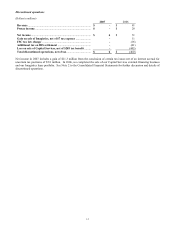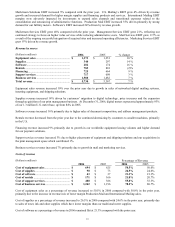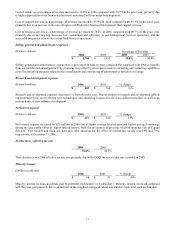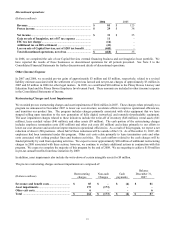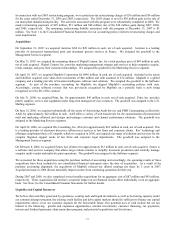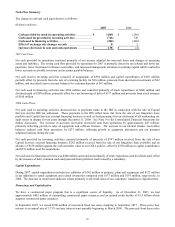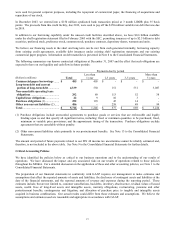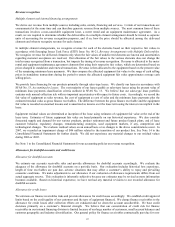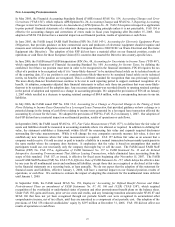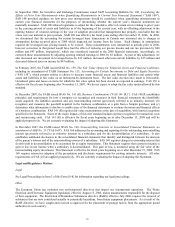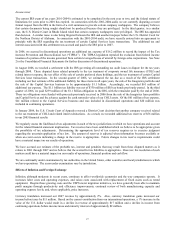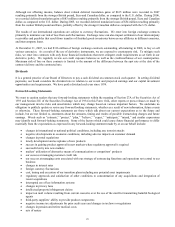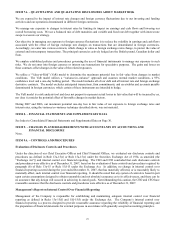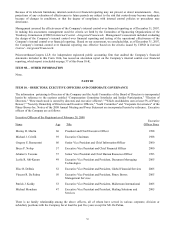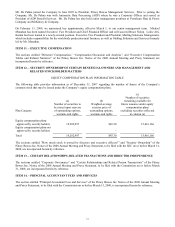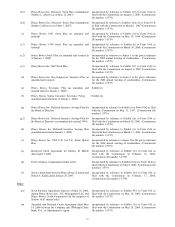Pitney Bowes 2007 Annual Report Download - page 42
Download and view the complete annual report
Please find page 42 of the 2007 Pitney Bowes annual report below. You can navigate through the pages in the report by either clicking on the pages listed below, or by using the keyword search tool below to find specific information within the annual report.24
See Note 14 to the Consolidated Financial Statements for further details on our transition initiatives and asset impairments
recorded in 2007. We believe that we have no unrecorded asset impairments at December 31, 2007. However, future events
and circumstances, some of which are described below, may result in an impairment charge:
• Changes in postal regulations governing the types of meters allowable for use.
• New technological developments that provide significantly enhanced benefits over current technology.
• Significant negative economic or industry trends.
• Changes in our business strategy that alters the expected usage of the related assets.
• Future economic results that are below our expectations used in the current assessments.
Pension benefits
Assumptions and estimates
The valuation and calculation of our net pension expense, assets and obligations are dependent on various assumptions and
estimates. We make assumptions relating to discount rates, rate of compensation increase, expected return on plan assets and
other factors. These assumptions are evaluated and updated annually and are described in further detail in Note 13 to the
Consolidated Financial Statements. The following assumptions relate to our U.S. qualified pension plan, which is our largest
plan. We determine our discount rate for the U.S. retirement benefit plan by using a model that discounts each year’ s
estimated benefit payments by an applicable spot rate. These spot rates are derived from a yield curve created from a large
number of high quality corporate bonds. Accordingly, our discount rate assumption was 6.15% at December 31, 2007 and
5.85% at December 31, 2006. The rate of compensation increase assumption reflects our actual experience and best estimate
of future increases. Our estimate of the rate of compensation increase was 4.50% at December 31, 2007 and 2006. Our
expected return on plan assets is determined based on historical portfolio results, the plan’ s asset mix and future expectations
of market rates of return on the types of assets in the plan. Our expected return on plan assets assumption was 8.50% in 2007
and 2006.
Sensitivity to changes in assumptions:
• Discount rate – a 0.25% increase in the discount rate would decrease annual pension expense by approximately $2.9
million.
• Rate of compensation increase – a 0.25% increase in the rate of compensation increase would increase annual
pension expense by approximately $2.5 million.
• Expected return on plan assets – a 0.25% increase in the expected return on assets of our principal plans would
decrease annual pension expense by approximately $3.9 million.
Delayed recognition principles
In accordance with SFAS No. 87, Employers’ Accounting for Pensions, actual pension plan results that differ from our
assumptions and estimates are accumulated and amortized over the estimated future working life of the plan participants and
will therefore affect pension expense recognized and obligations recorded in future periods. We also base our net pension
expense primarily on a market related valuation of plan assets. In accordance with this approach, we recognize differences
between the actual and expected return on plan assets primarily over a five-year period and as a result future pension expense
will be impacted when these previously deferred gains or losses are recorded. See the new accounting pronouncements
below for the effect of SFAS No. 158, Employers’ Accounting for Defined Pension and Other Post Retirement Plans an
amendment of FASB Statements No. 87, 88, 106 and 132(R).
Investment related risks and uncertainties
We invest our pension plan assets in a variety of investment securities in accordance with our strategic asset allocation
policy. The composition of our U.S. pension plan assets at December 31, 2007 was approximately 66% equity securities,
28% fixed income securities and 6% real estate investments. Investment securities are exposed to various risks such as
interest rate, market and credit risks. In particular, due to the level of risk associated with equity securities, it is reasonably
possible those changes in the values of such investment securities will occur and that such changes could materially affect
our future results.


